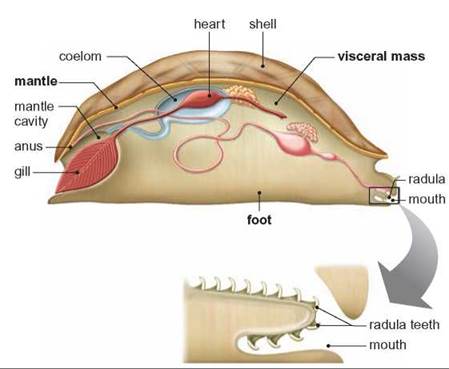CONCEPTS IN BIOLOGY
PART V. THE ORIGIN AND CLASSIFICATION OF LIFE
23. The Animal Kingdom
23.10. Mollusca
Like most other forms of animal life, the mollusks originated in the ocean, and, even though some forms have made the move to freshwater and terrestrial environments, most still live in the oceans. The members of this phylum display a true body cavity, a coelom. Reproduction is generally sexual; some species have separate sexes and others are hermaphroditic. They range from microscopic organisms to the giant squid, which is up to 18 meters long. A primary characteristic of mollusks is the presence of a soft body enclosed by a hard shell. They are not segmented but have three distinct body regions: the mantle, the foot, and the visceral mass. The mantle produces a shell and is involved in gas exchange, the foot is involved in movement, and the visceral mass contains the organs of digestion, circulation, and reproduction. Most of the mollusks have a tonguelike structure known as a radula, which has teeth on it. They use the radula like a rasp to scrape away at food materials and tear them to tiny particles that are ingested (figure 23.21).

FIGURE 23.21. Mollusk Structure
Mollusks are bilaterally symmetrical organisms with a coelom and a body composed of three body regions: the foot, the mantle, and the visceral mass.
Except for the squids and octopuses, mollusks are slow-moving benthic animals. Some are herbivores and feed on marine algae; others are scavengers and feed on dead organic matter. A few are even predators of other slow-moving or sessile neighbors. As with most other marine animals, the mollusks produce a free-swimming larval stage, which aids in dispersal. It is a ciliated trochophore larva similar to that seen in the annelids.
There are several kinds of mollusks; the most commonly observed are the chitons, bivalves, snails, and octopuses and squids (figure 23.22).

FIGURE 23.22. Mollusk Diversity
Mollusks range in complexity from small, slow-moving, grazing animals, such as chitons and snails, to clams, which are filter feeders, to intelligent, rapidly moving carnivores, such as octopuses.
The chitons are a primitive group of marine mollusks that have a series of eight shell plates along their back. They generally live on rocky surfaces and use their radula to scrape algae from the rocks. They can clamp onto their rocky substrate when disturbed. Many species are common along rocky shores.
Snails have a coiled shell. Most snails are benthic marine organisms, but some live in freshwater and moist terrestrial habitats. Slugs are a kind of snail that does not have a shell. Snails and slugs are extremely common and there are a huge number of different species. Many marine snails are carnivores.
The bivalves (clams, oysters, and mussels) are benthic marine and freshwater mollusks that have two shells. They also differ from other mollusks in that they are filter feeders and lack a radula.
Squids and octopuses have no external shell although a related organism—the nautilus—has a shell. They are marine animals that are active, rapidly moving predators. Squids are free-swimming predators, whereas octopuses are benthic and use ambushing as a way to capture prey.
23.10. CONCEPT REVIEW
25. Describe the general body plan of mollusks.
26. How does the lifestyle of a squid differ from that of a chiton?